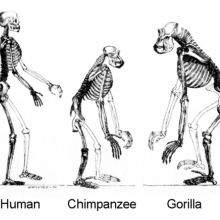With the help of Cambridge University's Professor Robert Foley, Sam Brown took a trip back in time to answer Stuart's question: "If you could bring a baby from the past to grow up in the present, how far back could you go before people would notice that this was a time travelling baby?"
In this episode

00:00 - When did we become modern day humans?
When did we become modern day humans?
With the help of Cambridge University's Professor Robert Foley, Sam Brown took a trip back in time to answer Stuart's question...
Robert - In evolutionary timescales, the answer is not very far. If we start the clock of human evolution at around 5 million years ago when the split from our last common ancestor with chimpanzees then probably up to around 200,000 years ago we would begin to see quite big differences. Before that not only would the babies look different but they would grow more rapidly and develop faster.
Sam - So being shorter and hairier, we might be able to pick them from a crowd. But what about behaviourally? Would they be able to function in today's society?
Robert - We don’t know enough in detail about their behaviour to say if they would stand out today. They would have probably learnt to speak, but perhaps not with the range of syntax and vocabulary we have. An interesting reason why we can’t be sure is that while people 200,000 years ago might not have had developed language like us, it could be that they would have had the mental capacity to learn it in a modern cultural setting.
We would probably have to go back to over half a million years ago to find them not speaking at all - perhaps the trait that would be most noticeable. It's a good question and echoes one I ask students, “If we found a living Neanderthal child should he or she be put in a school or a zoo?” Probably school, but what about earlier modern ancestors such as Homo erectus from 1 million years ago or Australopithecines at 3 million?
Sam - Fascinating stuff and another tricky question to finish off with too. But our forum users had even more to add. Halc suggests that one of the biggest challenges facing this time travelling infant would be growing up in the first place. He says the baby will not have the benefit of the last, say, million years of perpetual evolution between us and the stuff that's trying to kill us. The baby would have a hard time growing up at all since all these diseases that have bred to prey on humans will find the baby fairly defenceless. Well we better start working on some vaccines alongside that time machine then.
Related Content
- Previous The Great British Make Off
- Next Don’t call me Fruit Loops!









Comments
Add a comment